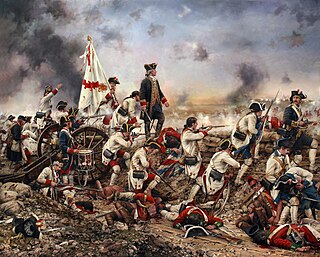Related Research Articles

Johann Elert Bode was a German astronomer known for his reformulation and popularisation of the Titius–Bode law. Bode determined the orbit of Uranus and suggested the planet's name.

René-Théophile-Hyacinthe Laennec was a French physician and musician. His skill at carving his own wooden flutes led him to invent the stethoscope in 1816, while working at the Hôpital Necker. He pioneered its use in diagnosing various chest conditions. He became a lecturer at the Collège de France in 1822 and professor of medicine in 1823. His final appointments were that of head of the medical clinic at the Hôpital de la Charité and professor at the Collège de France. He went into a coma and subsequently died of tuberculosis on August 13, 1826 at age 45.

1781 (MDCCLXXXI) was a common year starting on Monday of the Gregorian calendar and a common year starting on Friday of the Julian calendar, the 1781st year of the Common Era (CE) and Anno Domini (AD) designations, the 781st year of the 2nd millennium, the 81st year of the 18th century, and the 2nd year of the 1780s decade. As of the start of 1781, the Gregorian calendar was 11 days ahead of the Julian calendar, which remained in localized use until 1923.

Caroline Lucretia Herschel was a German born British astronomer, whose most significant contributions to astronomy were the discoveries of several comets, including the periodic comet 35P/Herschel–Rigollet, which bears her name. She was the younger sister of astronomer William Herschel, with whom she worked throughout her career.
The year 1787 in science and technology involved some significant events.
The year 1821 in science and technology involved some significant events, listed below.
The year 1826 in science and technology involved some significant events, listed below.
The year 1819 in science and technology involved some significant events, listed below.
The year 1816 in science and technology involved some significant events, listed below.
The year 1745 in science and technology involved some significant events.
The year 1848 in science and technology involved some significant events, listed below.
The year 1743 in science and technology involved some significant events.
The year 1882 in science and technology involved some significant events, listed below.
The year 1858 in science and technology involved some significant events, listed below.
The year 1786 in science and technology involved some significant events.
The year 1770 in science and technology involved some significant events.
The year 1750 in science and technology involved some significant events.

Pneumomediastinum is pneumatosis in the mediastinum, the central part of the chest cavity. First described in 1819 by René Laennec, the condition can result from physical trauma or other situations that lead to air escaping from the lungs, airways, or bowel into the chest cavity. In underwater divers it is usually the result of pulmonary barotrauma.

The Necker–Enfants Malades Hospital is a French teaching hospital in the 15th arrondissement of Paris. It is a hospital of the Assistance Publique – Hôpitaux de Paris group and is affiliated to the University of Paris Descartes. Necker–Enfants Malades Hospital was created in 1920 by the merger of Necker Hospital, which was founded in 1778 by Suzanne Necker, with the physically contiguous Sick Children's Hospital, the oldest children's hospital in the Western world, founded in 1801.

Modesty in medical settings refers to the practices and equipment used to preserve patient modesty in medical examination and clinics.
References
- ↑ Herschel, W.; Watson, Dr. (1781). "Account of a Comet, By Mr. Herschel, F.R.S.; Communicated by Dr. Watson, Jun. of Bath, F.R.S". Philosophical Transactions of the Royal Society . London. 71: 492–501. Bibcode:1781RSPT...71..492H. doi:10.1098/rstl.1781.0056. S2CID 186208953.
- ↑ "Verzeichniss aller bisher entdeckten Doppeltsterne" In Johann Elert Bode's Astronomisches Jahrbuch for 1784, pp. 183-6.
- ↑ Burke, James (1978). Connections . London: Macmillan. p. 196. ISBN 0-333-24827-9.
- ↑ "Coal Tar Before the Invention of Town's Gas" . Retrieved 2011-12-31.
- 1 2 Emsley, John (2001). Nature's Building Blocks: an A–Z guide to the elements. Oxford University Press. ISBN 978-0-19-850341-5.
- ↑ Hjelm, P. J. (1788). "Versuche mit Molybdäna, und Reduction der selben Erde". Der Königl. Schwedischen Akademie der Wissenschaften neue Abhandlungen aus der Naturlehre, Haushaltungskunst und Mechanik. Leipzig. 49: 268.
- ↑ "Copley Medal | British scientific award". Encyclopedia Britannica. Retrieved 21 July 2020.
- ↑ "Laennec, René-Théophile-Hyacinthe (1781-1826)". catalogue.bnf.fr (in French). Bibliothèque Nationale de France. Retrieved 6 February 2021.